Coming from the sunshine coast of Southern England
Old Eastbourne from pictures and photographs of the town
The earliest pictures of the town date from around the 18th century, long before the modern town evolved in the 19th century. Eastbourne stands on the ruins of the Roman city of Anderida but the only landmarks that can still be seen is the entrance to the Roman harbour known as Longus Portus, below the Wish Tower. This inlet once fed a harbour which was situated where the Devonshire Park now stands. At Pevensey stands a great Roman fortress. In Roman times the Count of the Saxon Shore's palace once stood on ground now covered by the Burlington and Queens hotel and under the Carpet Gardens.
An early picture of the area looking to the east, in the distance the sea houses.
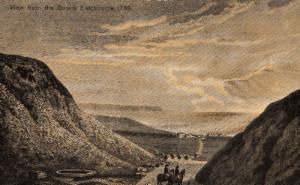
Left: View from the Downs 1789
Right : The original settlement of Burne from which the town gained its name. In the middle can be seen St Mary's church built in 1145.
.
This sketch shows the area around Marine Gardens. In those days coal barges regularly beached here allowing horse and carts to take the coal to the outlying villages.
In one of the sea houses Charles Darwin wrote part of his 'Orgins of Species' during his visits around 1850.
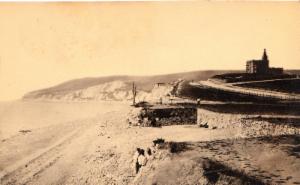
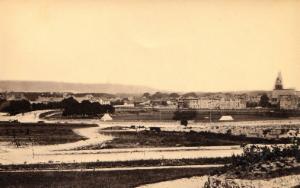
Left : Looking towards South Cliff from what is now the Western Laws
Right : The Links, before Eastbourne College was built.
Right : In June 1780, the children of George III spent their summer holiday in the Round House (formerly a windmill), which stood where thepier entrance is now situated. .
The Round House and Field House to the right, were demolished in 1841 owing to the encroachment of the sea.
Holywell in the 19th century was a chalk quarry before the Italian Gardens were created.
In the shadow of the parish church, this is the old post office in the Old Town.
King's Drive looking towards Hampden Park, no housing estates then, only pasture land as far as the eye could see.
Sheltered by the South Downs, this is the village of Willingdon, now very much part of Eastbourne.
Prior to the creation of Eastbourne from 1850 onwards, there were just four hamlets divided by pasture land. These were Seahouses, the Meads, Southbourne (around Grove Road) and Bourne that was the earliest Saxon settlement around Motcombe Gardens.
Bourne Place was built by James Burton around 1574. In 1724 the estate was sold to Spencer Compton who was later created Earl of Wilmington and the house was renamed Compton Place. He greatly enlarged the house between 1726 - 1731. It was here in the 19th century that the Earl of Burlington laid out the plans for his new town, to be called Burlington, but in 1850 he chose the name Eastbourne.
The first railway station was built in 1849 when the railway line was extended from Polegate.
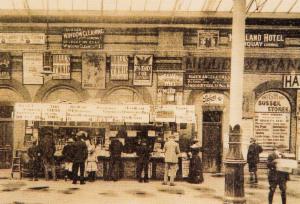
Inside Eastbourne Railway Station in 1906, showing the news stand and enamel hoardings.
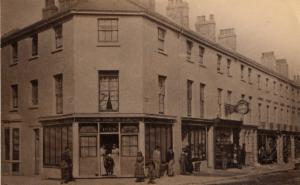
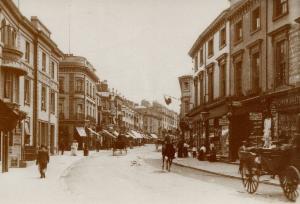
Left : Terminus Road at the corner of Trinty Trees.
Right : Terminus Road between Langney and Pevensey Road.
In 1850, Terminus Road was laid over a formerly muddy path to the sea. Within a few decades elegant hotels would be built all along the seafront.
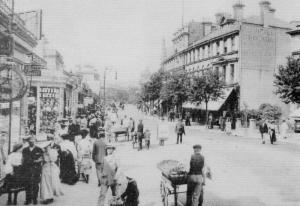
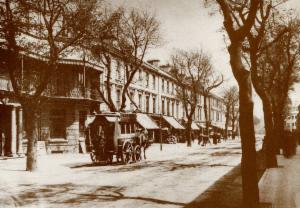
Left : Terminus Road opposite to the junction with Langney Road.
Right: Terminus Road Near to the Railway Station
This is Banker's Corner in Terminus Road looking towards the seafront in the 1920s. To the right, on the corner of Junction Road, stood this elegant building, Barclay's Bank. It was destroyed by a bomb during the Second World War, some of the stone was taken to Butts Brow where it is still used as a path marker, while the rest was buried at the top of Princes Park opposite the Sovereign Centre.
Another of Terminus Road, truly leafy Eastbourne, the Victorians loved their tree-lined streets
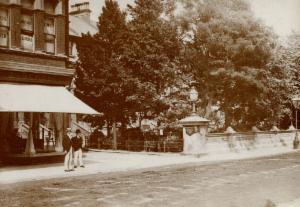
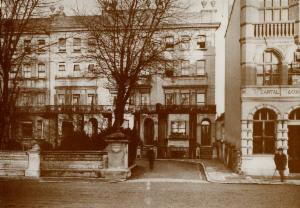
Left : The north entrance to Sussex Gardens in Terminus Road.
Right : The south entrance to Sussex Gardens in Terminus Road
College Road looking towards the Town Hall in 1900.
An 80 foot wide boulevard was originally intended to connect the railway station with the seafront, but this never came to be. At the seaward end is a statue to the 7th Duke of Devonshire who founded the town.
At the seaward end of Cavendish Place, opposite the pier, is this statue to the officers and men of the 2nd Royal Sussex Regiment. The building on the left, is were Friedrich Engels assisted Karl Marx in his revolutionary manifesto, known as Communism.

The Lion Steam Brewary and Malt House in Pevensey Road, near to the Terminus Road, Built in 1863 for Caleb Diplock and Son, it was demoished in 1920. The cellars still remain under the road between the buildings and what was the ABC cinema opposite.
For many years the village of Willingdon was separate to Eastbourne and stretched as far as Hampden Park. Even the railway station was known as Willingdon.
The foundation stone for Eastbourne's first lifeboat station at the Wish Tower, was laid on July 16th 1898 by the Dutchess of Devonshire. The station ceased active duty in 1924 and was reopened as a museum in 1937.
The 'dust carts' have changed a lot since this picture was taken around 1920. The person on the left of the photograph is my Grandfather (Harry Charman).
This is the fire station in Grove Road around 1900.
The Gas Works were once a feature at the east end of town, lying where Tesco's supermarket now stands. Every morning at 8am the Gas Works whistle would be sounded calling people to work, it was also sounded at midnight on New Year's Eve to celebrate the New Year.
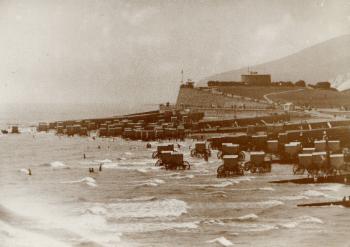
Bathing huts on the beach near to the Wish Tower, these later had their wheels removed and became the fore-runner of the bathing huts that stand beside the promenade today.
Royal Parade was not built until 1879, before that the buildings close to the sea were often flooded by the spring tides. In fact, the current tidal barrier along the promenade was built only a few decades ago and the hotels suffered up to then every spring from the pent-up fury of the English Channel.
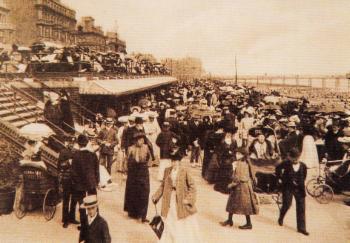
The middle parade in 1905, near to where the Central Bandstand now stands was a busy tourist area. Note the licenced bathchairs which used to be hired with their 'pullers and pushers' and elegant fashions of that era.
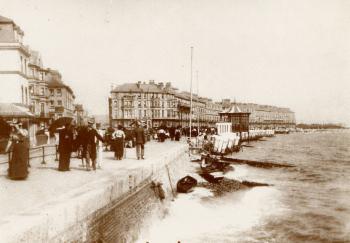
Marine Parade in 1895, with its bath machines stretching away into the distance and nearby the bird-cage bandstand. No railings to stop you falling into the sea then and note the boats against the seawall.
Pride of place was the Cavendish Hotel on the corner of Devonshire Place. On Monday, May 4th 1942 it received a direct hit from a German bomb. Now only half of the original Victorian architecture remains, the wing was rebuilt after the war in a modern squared design.
This is the Mansion Hotel in the 1920s, on the corner of Grand Parade and Hartington Place.
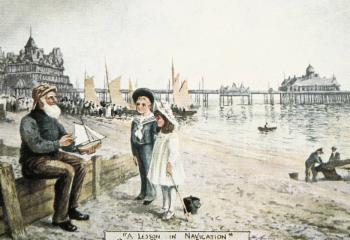
A artist's impression of Eastbourne's seafront at the turn of the 19th century.
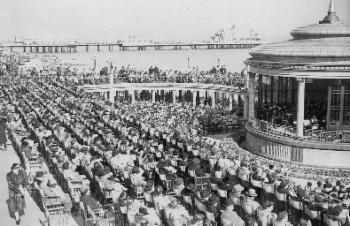
The Central Bandstand on Grand Parade was opened in 1935, with an audience seating capacity of 3000 people. It was considered one of the best designed bandstands in Britain. This picture was taken in 1948, at the height of the post war holiday boom in Eastbourne.
Little has changed from the early years of the twentieth century. This is Mead's Street beside St Andrew's School
Left : Meads Street beside St Andew's School, little changed over the years.
Right : This is the junction of Terminus Road and Seaside Road, taken during the big freeze of 1903.
At times like this, one is reminded that much of the town lies below sea level.
With the completion of Royal Parade, much of the intensity of the spring tides moved to what became known as Redoubt Splash Point.
The Victorian shelter at the Redoubt was taken down in the 1960s, each piece carefully marked for reassembly which never took place.
Sunday afternoon at the Redoubt Music Gardens at the turn of the 20th century.
Motor coaches outside the YMCA in Bolton Road.
This is South Street in 1870, looking from Gildredge Road towards the Town Hall.
This is South Street in 1870 looking from Grove Road down towards St Saviour's Church
The seafront at the turn of the 20th century, in the picture is one of the first Eastbourne buses with solid tyres. Eastbourne started the first municipally owned motor omnibus service on April 12th 1903.
Before the present Grand Parade bandstand was built in 1935, bands played here in this bird cage bandstand.
The seafront from Eastbourne Pier
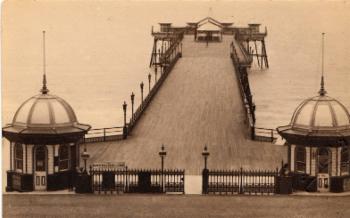
Eastbourne Pier officialy opened on June 13th 1870, later building structures where added to the decking. At first, this was simply a platform for the boarding and discharge of passengers from paddle and screw steamers.
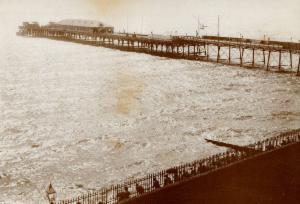
On January 1st 1877, a severe storm completely washed away the the whole of shoreward end. That is why the pier now has a slope midway connecting the two sections.
The theatre at the end of the pier was built in 1888, it orginally seated 400 people, in 1899 a larger building was erected, it included a bar, cafe and the pier offices. On the top was a camera obscura which by the use of lens, mirror and round canvas screen projects a picture 360 degrees of the seafront right and out to sea, operated from a hand windlass.
In 1925, a music pavilion to seat 900 people was built at the seaward end.
The first performance of 'talking pictures' in Eastbourne was shown at the pier theatre.
During the 1st World War the Knuts Kamp Komedy Kompany from Summerdown Convalescent Camp performed in the bird cage bandstand.
Gildredge Park was purchased by the Council in 1908, here sheep graze in the parkland.
A rustic path beside the lake in Hampden Park just after the Council had purchased the park and opened it to the public on August 12th 1902.
Motcombe Gardens were a gift to the town from the Duke of Devonshire 1908. It was orginally part of Motcombe Farm.
Beachy Head is the highest cliff on the south coast of Britain, 575 feet above sealevel. The foreshore is known as Falling Sands. The name Beachy is derived from the old French beau-chef, fair head or promontory.
Seven miles off Eastbourne lie the
Royal Sovereign rock shoals once guarded by this lightship and now by a tower. The shoal was named after a one-hundred gun warship wrecked here in 1757. It was believed to be the Royal Sovereign, but at the time that ship was on harbour duty at Chatham. Speculation still remains about the mystery ship that lies below these waters.
The seafront in 1870, just after the pier in the background was erected.
The seafront in 1909, looking from the Wish Tower slopes
This tram line once ran from the top of Channel View Road to Wartling Road. The trams were housed in sheds that were originally part of the aircraft factory built by Major Bernard Fowler in 1913. The trams still run today, but in Devon.